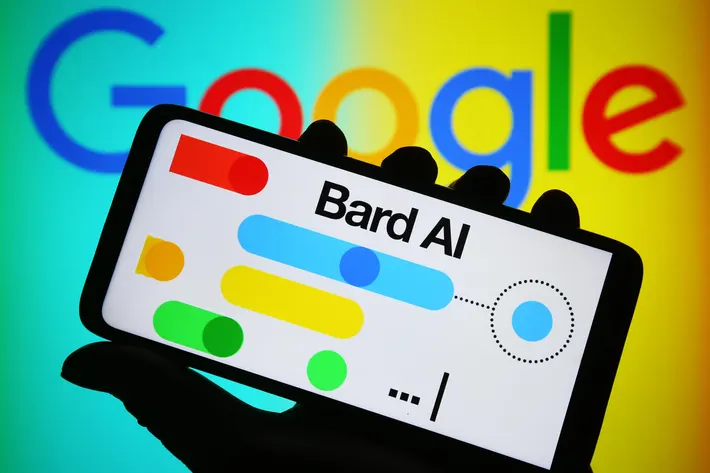Google Bard: The AI Titan That’s Redefining the Future of Technology
Artificial Intelligence (AI) is no longer a futuristic concept—it’s here, and it’s transforming the way we live, work, and interact with the world. Among the tech giants pioneering this AI revolution,
Google stands tall as a leader, consistently pushing the boundaries of innovation.
At the heart of Google’s AI advancements lies Google Bard, an extraordinary AI model that is not only shaping the future but is set to eclipse its own legacy.
In this deep dive, we’ll explore what makes Google Bard so unique, how it has evolved,
and what the future holds for this groundbreaking technology.
Whether you’re a tech enthusiast, a business leader, or simply curious about the latest in AI, this article will give you everything you need to know about Google Bard.
What Exactly is Google Bard?
Picture this: an AI that doesn’t just understand what you say but grasps the context,
anticipates your needs, and delivers responses that feel as natural as a conversation with a friend.
That’s Google Bard in a nutshell—a state-of-the-art AI chatbot designed to simulate human-like conversations using the most advanced natural language processing (NLP) and machine learning techniques available.
Originally launched under the name Gemini, Google Bard represents a significant leap forward from its predecessors.
It’s not just another tool for answering queries or assisting with searches; Bard is a multimodal AI model, meaning it can process and generate content across various data types,
including text, audio, code, and even video. This versatility makes Bard one of the most powerful and adaptable AI models in existence.
The Journey of Bard: From Concept to Reality
Google Bard didn’t just appear out of thin air—it’s the result of years of research, development, and innovation by Google’s top minds.
The journey began with its official announcement on February 6, 2023, positioning Bard as a next-gen AI chatbot focused on conversational AI. However, it wasn’t until March 21, 2023,
that users got their first taste of Bard, after Google opened up a waitlist for early access.
The global rollout was swift and ambitious. By May 10, 2023, Bard was available in over 180 countries, showcasing Google’s commitment to making this cutting-edge technology accessible to people all around the world.
But why the rush? Many believe Google accelerated Bard’s development to counter the meteoric rise of ChatGPT, a competing AI language model.
The pressure was immense, and during Bard’s initial live demonstration, things didn’t go exactly as planned.
An error in response to a query about the James Webb Space Telescope led to a $100 billion drop in Google’s market value. Despite this early hiccup, Google remained undeterred, refining Bard and expanding its capabilities at an astonishing pace.
Today’s Bard: A Multimodal Marvel
Fast forward to today, and Google Bard has evolved into a multimodal marvel—a tool that’s not just capable of understanding text but also interpreting audio, analyzing images, and even processing video.
This is where Bard truly shines; it’s not just another AI but a comprehensive solution that can tackle a wide array of tasks by understanding and integrating multiple forms of data.
Imagine being able to input a handwritten note, a complex graph, or even a series of video frames, and having Bard process it all seamlessly.
Bard’s architecture is designed to handle this, processing different types of input data simultaneously and delivering accurate, context-aware responses. This capability is a game-changer,
opening up new possibilities for businesses, developers, and users alike.
How Google Bard Works: The Magic Behind the Machine
The magic of Google Bard lies in its advanced training and sophisticated architecture. Built on a transformer model-based neural network,
Bard has been fine-tuned to process lengthy contextual sequences across different modalities—text, audio, and video.
Google DeepMind, the powerhouse behind Bard, has implemented cutting-edge data filtering techniques to optimize the AI’s training process.
By being trained on diverse multimodal and multilingual datasets, Bard can understand and generate content in various languages and formats, making it a truly global AI model.
But what really sets Bard apart is its use of Google’s latest tensor processing unit (TPU) chips, particularly the TPU v5.
These custom AI accelerators are designed to efficiently train and deploy large models like Bard, making it one of the most powerful AI tools available today.
Safety First: Tackling the Challenges of AI
AI is powerful, but with great power comes great responsibility.
Google Bard is no exception, and Google has taken extensive measures to ensure that Bard operates safely and ethically.
This includes addressing potential risks like bias and the generation of harmful content.
To mitigate these risks, Bard has undergone rigorous safety testing.
It has been evaluat across various academic benchmarks, spanning domains like language, image, audio, video, and code.
These evaluations are part of Google’s broader commitment to AI safety, ensuring that Bard adheres to strict ethical guidelines.
Bard’s Versions: Tailored for Every Need
One size doesn’t fit all, especially in the world of AI. Google Bard is not just a single model; it’s a series of models design to cater to different needs and environments. As of December 13, 2023, Google had rolled out multiple versions of Bard, each tailored to specific use cases:
- Bard Ultra: The premium version, designed for highly complex tasks requiring advanced reasoning and understanding.
- Bard Pro: Optimized for performance and scalability, making it ideal for large-scale deployments.
- Bard Nano: A lightweight model design for mobile devices and applications where computational resources are limited.
This variety allows users to choose the Bard version that best suits their needs, whether they’re developing cutting-edge AI applications or simply looking for a more efficient way to manage daily tasks.
Who Can Access Google Bard?
Accessibility is key, and Google Bard is widely available to users across the globe. Bard Pro, the most widely used version, is accessible in more than 230 countries and territories. Meanwhile,
Bard Advanced is available in over 150 countries, reflecting Google’s commitment to making AI technology available to as many people as possible.
However, there are age restrictions in place to comply with local laws.
In most countries, users must be at least 18 years old and have a personal Google account to access Bard. In some regions, the minimum age is 13, provided there’s parental consent.
Is Google Bard Free?
When Google Bard first launched, it was free for users, aligning with Google’s tradition of offering free services to the public.
However, as Bard evolved and expanded its capabilities, Google introduced a paid tier to unlock more advanced features.
As of February 8, 2024, Bard remains free to use, but certain features—particularly those offer by the Ultra model—are lock behind a paywall.
To access these features, users can subscribe to Bard Advanced for $20 per month.
This subscription is part of the Google One AI Premium package, which also includes additional Google Workspace features and 2 TB of storage.
What Can You Do with Google Bard?
The real question is, what can’t you do with Google Bard? Its applications are vast and varied, thanks to its multimodal capabilities. Here are just a few examples of what Bard can do:
- Text Summarization: Simplify complex documents and lengthy articles into concise summaries.
- Text Generation: Create high-quality content, from articles and blog posts to chatbot responses, with ease.
- Text Translation: Break down language barriers with Bard’s multilingual translation capabilities.
- Image Understanding: Analyze and interpret images, including complex visuals like charts and diagrams, without needing external tools.
- Audio Processing: Recognize and transcribe speech in over 100 languages, and perform audio translation tasks.
- Video Understanding: Analyze video frames to answer questions, generate descriptions, and more.
- Multimodal Reasoning: Process different types of data simultaneously to generate complex, context-aware responses.
- Code Analysis and Generation: Understand, explain, and even generate code in popular programming languages like Python, Java, C++, and Go.
Where is Google Bard Being Use?
Google Bard isn’t just a standalone tool; it’s integrated into a wide range of products and services, making it a foundational model for multiple applications. Here are some of the most notable integrations:
- AlphaCode 2: Google DeepMind’s AlphaCode 2 uses Bard Pro for code generation tasks, revolutionizing the way developers write and analyze code.
- Google Pixel: The Pixel 8 Pro smartphone is the first device to run Bard Nano, leveraging its capabilities for features like Smart Reply in messaging apps.
- Android 14: Android developers can now integrate Bard Nano through the AICore system to build AI-driven applications, enhancing the user experience.
- Vertex AI: Google Cloud’s Vertex AI service provides developers with access to Bard Pro, enabling them to build custom AI applications with unprecedented ease.
- Google AI Studio: Developers can use Google AI Studio to prototype and develop applications using Bard, making it easier to bring innovative ideas to life.
- Search Generative Experience: Google is experimenting with integrating Bard into its Search Generative Experience to improve search quality and reduce latency, potentially transforming how we search for information online.
The Future of Google Bard: What’s Next?
The future of Google Bard is incredibly bright. Since its inception, Bard has continuously evolved, with new features and capabilities being added regularly.
One of the most anticipated updates is the rollout of Bard’s voice assistant features, which promise to bring conversational AI to a whole new level.
Imagine interacting with an AI that can understand and respond to your voice commands, whether you’re asking for directions, setting reminders, or even controlling smart home devices.
Moreover, Google is investing heavily in making Bard more secure, reliable, and ethical.
With the rise of AI, concerns about data privacy, bias, and misuse have grown, and Google is committ to addressing these issues head-on. Expect to see more robust safeguards, user controls, and transparency in how Bard operates.
Read More: Janmashtami 2024 Celebration Guide, Rituals, and Bank Holidays Across India
Conclusion: Why Google Bard is the Future of AI
In a world where technology is advancing at breakneck speed, Google Bard stands out as a beacon of innovation. Its ability to seamlessly integrate multimodal data, deliver highly contextual responses,
and scale across various applications makes it a game-changer in the AI landscape.
But Bard is more than just a technological marvel; it’s a tool that’s poised to change the way we interact with the digital world.
From improving productivity to breaking down language barriers,
Bard has the potential to make our lives easier, more connected, and more informed.
As AI continues to evolve, one thing is clear: Google Bard is leading the charge, and its influence will only grow stronger in the years to come.










